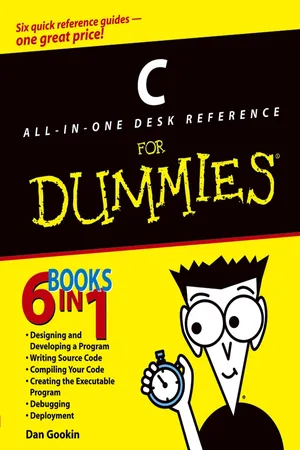
- English
- ePUB (mobile friendly)
- Available on iOS & Android
C All-in-One Desk Reference For Dummies
About this book
Ready, set, code! A user-friendly guide introducing the C programming language to new and intermediate coders
The C programming language and its direct descendants are widespread and among the most popular programming languages used in the world today. The enduring popularity of C continues because C programs are fast, concise, and run on many different systems. Flexible and efficient, C is designed for a wide variety of programming tasks: system-level code, text processing, graphics, telecommunications, and many other application areas. C All-in-One Desk Reference For Dummies is for beginning and intermediate C programmers and provides a solid overview of the C programming language, from the basics to advanced concepts, with several exercises that give you real-world practice.
C All-in-One Desk Reference For Dummies covers everything users need to get up to speed on C programming, including advanced topics to take their programming skill to the next level. Inside you'll learn
- The entire development cycle of a C program: designing and developing the program, writing source code, compiling the code, linking the code to create the executable programs, debugging, and deployment
- The intricacies of writing the code -- the basic and not-so-basic building blocks that make up the source code
- Thorough coverage of keywords, program flow, conditional statements, constants and variables, numeric values, arrays, strings, functions, pointers, debugging, prototyping, and more
- Dozens of sample programs you can adapt and modify for your own use
Written in plain English, this friendly guide also addresses some advanced programming topics, such as
- Programming for the Linux/Unix console
- Windows and Linux programming
- Graphics programming
- Games programming
- Internet and network programming
- Hardware programming projects
The book includes a handy appendix that shows you how to set up your computer for programming, how to select and use a text editor, and fix up the compiler, to ensure you're ready to work the author's examples. Written by Dan Gookin, the author of the first-ever For Dummies book (and several others) who's known for presenting complex material in an easy-to-understand way, this comprehensive guide makes learning the C programming language simple and fun. Grab your copy of C All-in-One Desk Reference For Dummies, so you can start coding your own programs.
Frequently asked questions
- Essential is ideal for learners and professionals who enjoy exploring a wide range of subjects. Access the Essential Library with 800,000+ trusted titles and best-sellers across business, personal growth, and the humanities. Includes unlimited reading time and Standard Read Aloud voice.
- Complete: Perfect for advanced learners and researchers needing full, unrestricted access. Unlock 1.4M+ books across hundreds of subjects, including academic and specialized titles. The Complete Plan also includes advanced features like Premium Read Aloud and Research Assistant.
Please note we cannot support devices running on iOS 13 and Android 7 or earlier. Learn more about using the app.
Information
Chapter 1: Your Basic C Program
In This Chapter




The Section Where the Author Cannot Resist Describing the History of C
Time to Program!
The basic, simplest C program
Table of contents
- Title
- Contents
- Introduction
- Book I : Hello, C
- Chapter 1: Your Basic C Program
- Chapter 2: How It All Works
- Chapter 3: More Basics, Comments, and Errors
- Chapter 4: Introducing Numbers and Variables
- Chapter 5: More Variables and Basic I/O
- Chapter 6: Decision Time
- Chapter 7: Looping
- Chapter 8: Using Constants
- Chapter 9: Mysterious Math
- Chapter 10: It’s Only Logical
- Book II : Middle C
- Chapter 1: Variables from Beyond Infinity
- Chapter 2: The Madness of Printf()
- Chapter 3: Maniacal Math Functions
- Chapter 4: Not Truly Random
- Chapter 5: While Going Loopy
- Chapter 6: More Decision Making
- Chapter 7: The Goto Chapter
- Book III : Above C Level
- Chapter 1: Asking for Arrays
- Chapter 2: I Sing of Strings
- Chapter 3: Messing with Characters
- Chapter 4: Stinkin’ Structures
- Chapter 5: Creating Your Own Functions
- Chapter 6: Quitting Before You’re Done
- Chapter 7: More Variable Nonsense
- Book IV : Advanced C
- Chapter 1: Introduction to Evil Pointers
- Chapter 2: Getting to the *Point
- Chapter 3: Binary Bits
- Chapter 4: The Myth of the Array
- Chapter 5: Pointers and Strings
- Chapter 6: Crazy Arrays of Pointers
- Chapter 7: Functions and Pointers
- Chapter 8: Structures, Pointers, and the Malloc Deity
- Chapter 9: Does Anyone Have the Time?
- Chapter 10: Building Big Programs
- Chapter 11: Help!
- Book V : Disk Drive C
- Chapter 1: Just Your Standard I/O
- Chapter 2: Interacting with the Command Line
- Chapter 3: Hello, Disk!
- Chapter 4: More Formal File Writing and Reading
- Chapter 5: Random Access Files
- Chapter 6: Folder Folderol
- Chapter 7: Under New File Management
- Book VI : The Joy of Linked Lists
- Chapter 1: Why Linked Lists?
- Chapter 2: Dawn of the Database
- Chapter 3: Storing a Linked List on Disk
- Chapter 4: The Nightmare of the Double-Linked List
- Book VII : Appendixes
- Appendix A: The Stuff You Need to Know before Reading Everything Else in This Book
- Appendix B: ASCII Table
- Appendix C: Answers to Exercises
- Appendix D: C Language Keywords and Operators
- Appendix E: C Language Variable Types
- Appendix F: Escape Sequences
- Appendix G: Conversion Characters